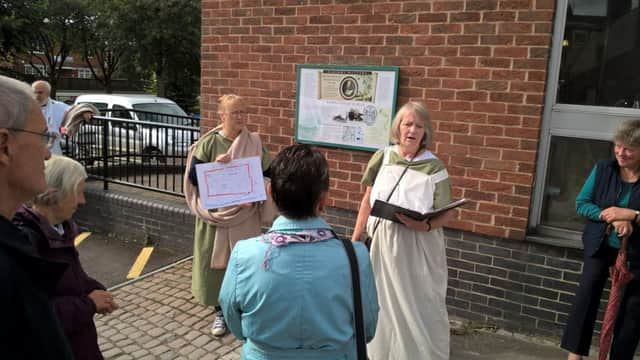Mystery surronds Roman history in Horncastle


She would love to see Horncastle’s Roman walls play a leading role in plans to attract more visitors to the town.
Others - including councillors and prominent leaders - share her views.
Advertisement
Hide AdAdvertisement
Hide AdOn the face of it, there is a strong case for a fresh focus on the walls.
They were formidable defences - built higher and thicker walls at many major settle, including Lincoln.
The walls also featured ‘integral’ bastions - almost unique in Roman Britain.
To add to the intrigue, there was an unusual gate system with overlapping walls slowing down the final approach.
Advertisement
Hide AdAdvertisement
Hide AdWhy the Romans attached so much importance to Horncastle has baffled eminent historians for years.
There have been lots of interesting finds - from coins to pottery and even skeletons.
But nothing has been unearthed of military importance.
Some argue the walls protect salt on its journey from the East Coast to the hinterland. Romans valued salt more than gold.
But, the road structure was not a feature of the local landscape 2,000 years ago.
Advertisement
Hide AdAdvertisement
Hide AdNow, historians believe Horncastle was built as a Shore Fort - to offer protection against marauding Saxon invaders in the latter stages of Roman occupation.
Mrs Jonkers admits the truth may never be known.
However, while the speculation continues you cannot fault the commitment of her and other enthusiasts to protect the walls for future generations.
Mrs Jonkers would modestly describe herself as a ‘keen amateur’ when it comes to history.
The truth is few know Roman Horncastle as well as her.
As Mrs Jonkers points out, Horncastle is missing a trick by not cashing in on all the history and intrigue.
Advertisement
Hide AdAdvertisement
Hide AdIndeed, one prominent businessman suggests if Horncastle was anywhere else in the country there would be a whole industry - and a regular stream of visitors - attracted to the town.
OK, it might not be the stuff of Tintagel and King Arthur, or King Harold and Hastings.
Surely, Banovallum - if indeed that was the name of Roman Horncastle - has a fascinating story to tell everyone.
At long last, there are positive moves afoot to make more of the walls - what remains of them.
Advertisement
Hide AdAdvertisement
Hide AdSome sections are firmly ‘locked behind’ closed doors on privately owned land but surely if Horncastle is serious about boosting tourism, then events of 2,000 years ago should play a leading role.
The next few weeks could be crucial in any ambitious plans to preserve the Roman walls for this - and future - generations.
A study is due to be published on how best to protect the walls.
Initial work has been carried out - focusing on removing vegetation which was in danger of causing remaining sections of the wall to collapse.
Advertisement
Hide AdAdvertisement
Hide AdThe study has been put together by English Heritage who helpeDfund the initial work.
As ever, money will decide what level of preservation can be carried out.
Mrs Jonkers and others are hoping volunteers will come forward to help.